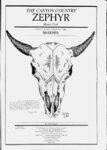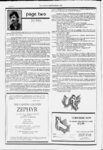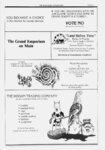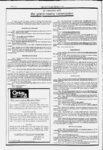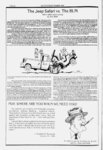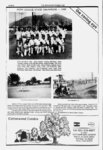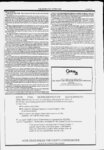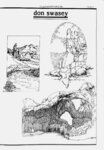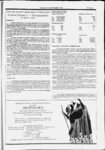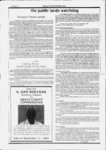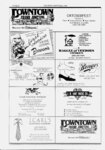| OCR Text |
Show THE ZEPHYRSEPTEMBER 1990 PAGE 26 1890, and Moab was named the county seat. The population of the county in 1940 was approximately 2,000, most of whom derived their livelihood from sheep and cattle. The Grand County Fair, a three-da-y festival held in October, includes a rodeo and livestock ; show. Supervisory offices of the La Sal National Forest are at Moab. The Old Irrigation Canal Arroyo, 50 to 300 yards west of US 160 through Moab, is the channel carved by the irrigation stream Looking Back A UTAH GUIDE TO THE left running when Indians drove Mormon missionaries from the valley in 1855. The Big Cottonwood Tree, northwestern Moab, is the largest known tree in Utah. Its trunk is 8.2 feet in diameter. Planted about 1880 by L. B. Bartlett, it now stands in the middle of a road; sheer size saves it from removal. STATE Compiled by W orkers of the WTiters' Program h ork the W Projects Administration of i for Boats and guides are available at Moab for trips down the Colorado River. trip from Moab to the head of Cataract Canyon, 10 miles below the junction of the Colorado and the Green, can be made with comparative trip safety. Below this point navigation is difficult and dangerous. A can be made up the Green from its junction with the Colorado to the town of Greenriver. Beginning with the launching of the Major Powell in 1891, unsuccessful attempts were made to establish navigation service between Moab and Green-riv(jee Tour 7a). Improved overland highways ended these experiments, g and today (1940) navigation is mostly confined to trips. In 1923 Ross Thomson and Mike ONeil made the trip from Moab to the junction in a canoe, covering the distance in 10 hours and 21 minutes. The following year William Tibbetts and Tom Perkins also made haste down the river. Escaping from the Moab county jail, where they were being held for cattle theft, they started in a rowboat. They were pursued by officers in a motorboat. Almost overtaken, they landed and escaped into the adjacent canyon country. They rfere never recaptured. West of Moab, the Colorado pierces towering cliffs that surround the valley, and begins its long imprisoned journey through canyons thousands of feet deep. Along the route are natural bridges, arches, windows, buttes, pinnacles, monuments a continuous, constantly-changin- g display of strange and remarkable formations carved in naked red rock. At HYS BOTTOM, 8.5 m., a foot trail (L) leads up the side of the cliff, through a cleft in the sandstone walls, then follows the canyon rim for a short distance, and descends to the Petroclyph of the Mastodon, the riddle of the Colorado. The mastodon is an ancient drawing chipped in red sandstone. It measures 42 inches from snout to rump, and is 14 inches high at the shoulders. The upturned trunk is shorter than that of an elephant. The petroglyph was discovered in 1924 by John Bristol, Moab newspaperman, but little information regarding the strange carving was circulated until 1933, when Dr. on Byrds first Antarctic ExpediLawrence M. Gould, geologist-geographtion, visited and photographed it. Weathering of the sandstone in which the drawing is cut proves that it is very old. It is 300 feet above the present river bed far above other petroglyphs along the stream. Scientists are generally agreed that early man carved only images of what he actually saw, but the mastodon is said to have been extinct for 30,000 years 15,000 years before the supposed advent of man. This gives rise to speculation as to whether man was here 30,000 years ago, or whether the mastodon survived until 15,000 years ago. The Mastodon petroglyph remains the riddle of the Colorado. The the State of Utah 75-mi- le 90-mi- 1941 MOAB, 31.9 m. ( 4,042 ,alt., 883 pop.), seat of Grand County, is the commercial center of an extensive sheep and cattle country, and since 1930 has achieved importance as a point of departure for scenic attractions in southeastern Utah. Though isolated it has a small business district, selling everything from hay and gasoline to malted milk and liquor the only "legal liquor in the county. Squat red adobe houses stand neighbor to more pretentious firebrick houses. In the evening neon lights illuminate the business district, but after midnight, except on Saturdays, the town does a complete "blackout. Moab has green trees, green lawns, green fields, but even this greenness comes from red soil. The town is on the Colorado River, which has an average annual flow of more than six million acre-fee-t, but gets its water from Mill Creek and Pack Creek, small streams The Colorados water-levflowing out of the La Sal Mountains. fluctuates so greatly that any attempt by Moab farmers to divert its water would be an invitation for the river to flood the town. As a matter of historical record, in 1884 the river rose so high that, without benefit of diversion canals, it flooded the lower end of the valley. The first attempt to settle Moab Valley came in 1855, with establishment of a mission in the Elk Mountains (now the La Sals). Adof provance preparations were made in 1854, when five wagon-load- s visions were cached in the valley. The following spring, the Church called forty-on- e men to establish the mission. The group left Great Salt Lake City in May, taking with them fifteen wagons, thirteen horses, sixty-fiv- e oxen, sixteen cows, two bulls, one calf, two pigs, twelve chickens, four dogs, flour, wheat, oats, corn, potatoes, peas, five plows, twenty-tw- o axes, and other tools. the Colorado River in reached The company and found the valley abounding with the largest d had ever of us any seen, which we took as an indication of good farming land. . . . About the center of the valley we came to the lands cultivated by the Indians. . . . Loose soil and rubbish was piled in ridges, forming dams, Soon all hands by which the land was flooded in small quantities. were busily engaged in grubbing brush, plowing land, building a dam but the dam being in sandy land, it broke away . . . and ruined the site, which obliged us to go a mile farther up the creek and take water from a beaver dam. the men had planted crops and built a stone fort. By mid-Jul- y held They friendly meetings with the Indians, converted and baptized some of them. During late September, in a sudden series of attacks, Indians killed three of the Mormons and set fire to haystacks and log fences. The missionaries abandoned the fort the next morning "without eating breakfast. They departed so hurriedly that water was left running in the irrigation canal from Mill Creek. Water continued to run through this ditch, year after year, until eventually it carved an arroyo twenty-fiv- e feet deep. The next settlers were probably two brothers, George and Silas Green, who brought 400 cattle into the valley about 1875. They were apparently killed by Indians. In the summer of 1877 two prosn pectors, William "Nigger Bill Granstaff, a mulatto, and a known only as "Frenchie took possession of the fort, and laid claim to the valley. In 1878 A. G. Wilson made a trade with Frenchie for his land, but when he returned with his family the following spring the Frenchman had traded the same land to Walter Moore, and had left the valley. The mulatto, however, remained until 1881. In that year the settlers had their last trouble with the Indians. A band of Paiutes and Navahos from Colorado came into the La Sal Mountains, killing and plundering settlers who grazed their cattle there. After a running fight in which ten whites and Indians were killed, the Indians were driven back to twenty-seve- n reservation. their During this trouble Nigger Bill, accused of selling whisky to the Indians, fled into Colorado by way of Nigger Bill Canyon see above), A post office was established in 1879, and a committee chose the Biblical name Moab for the town. Grand County was created in el le er sight-seein- 65-mi- -- le 16-fo- ot er mid-Jun- e, sage-woo- ... zeke and maralee francis Four Corners Design (across from the post office ) COME ON IN WITH THE KIDS BACK IN SCHOOL, ITS QUIETER HERE. relatively speaking French-Canadia- oldest irt shop in moab estb. 1980 |
